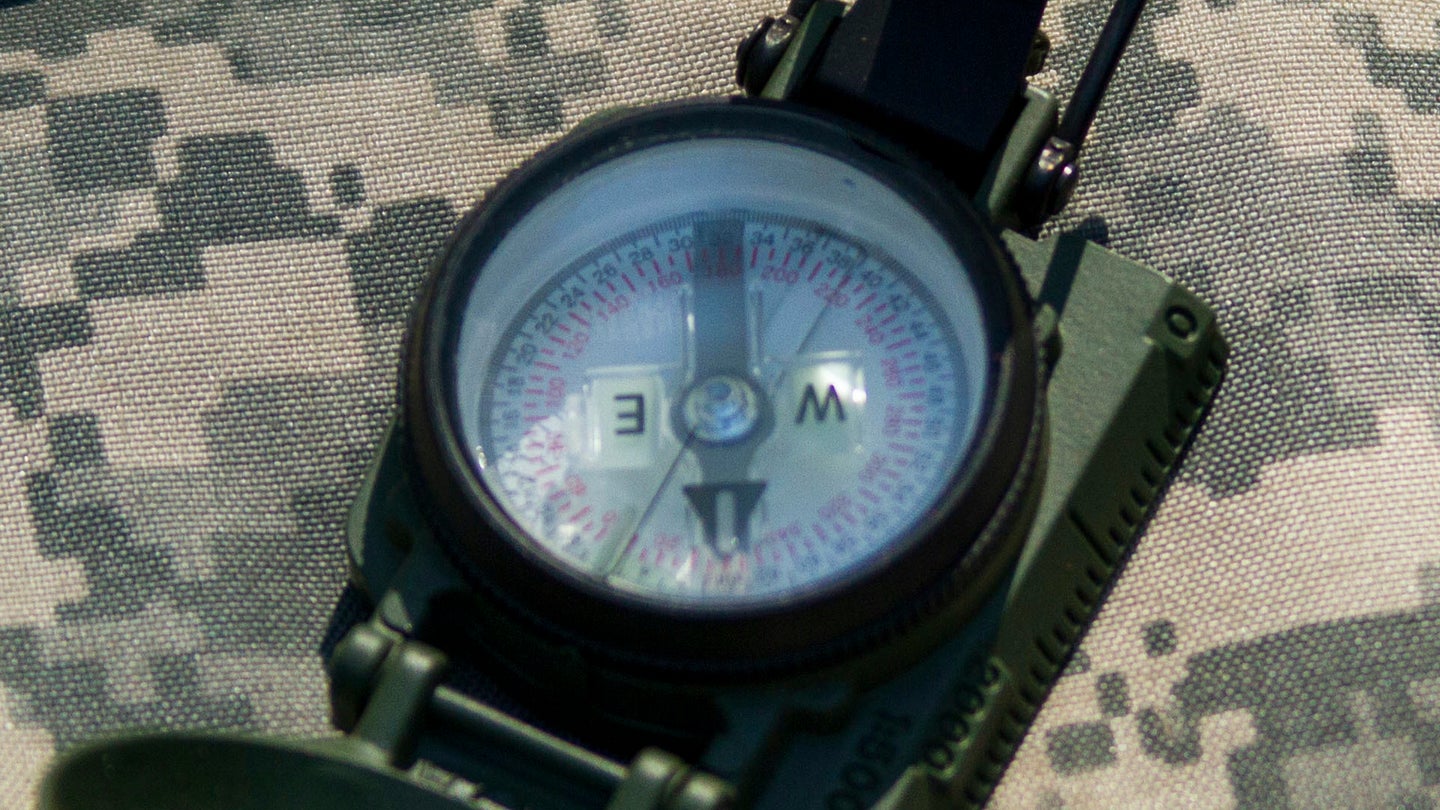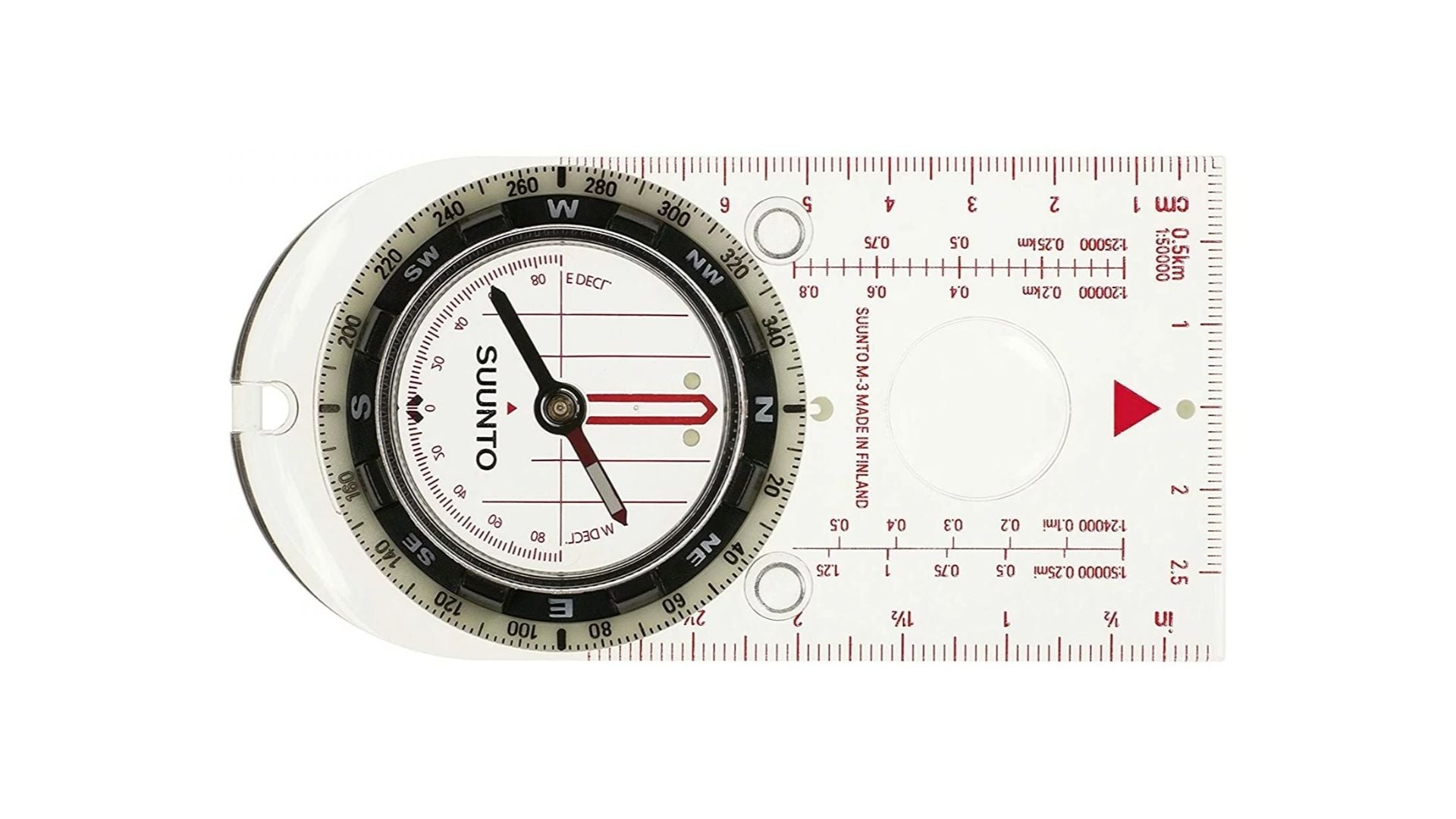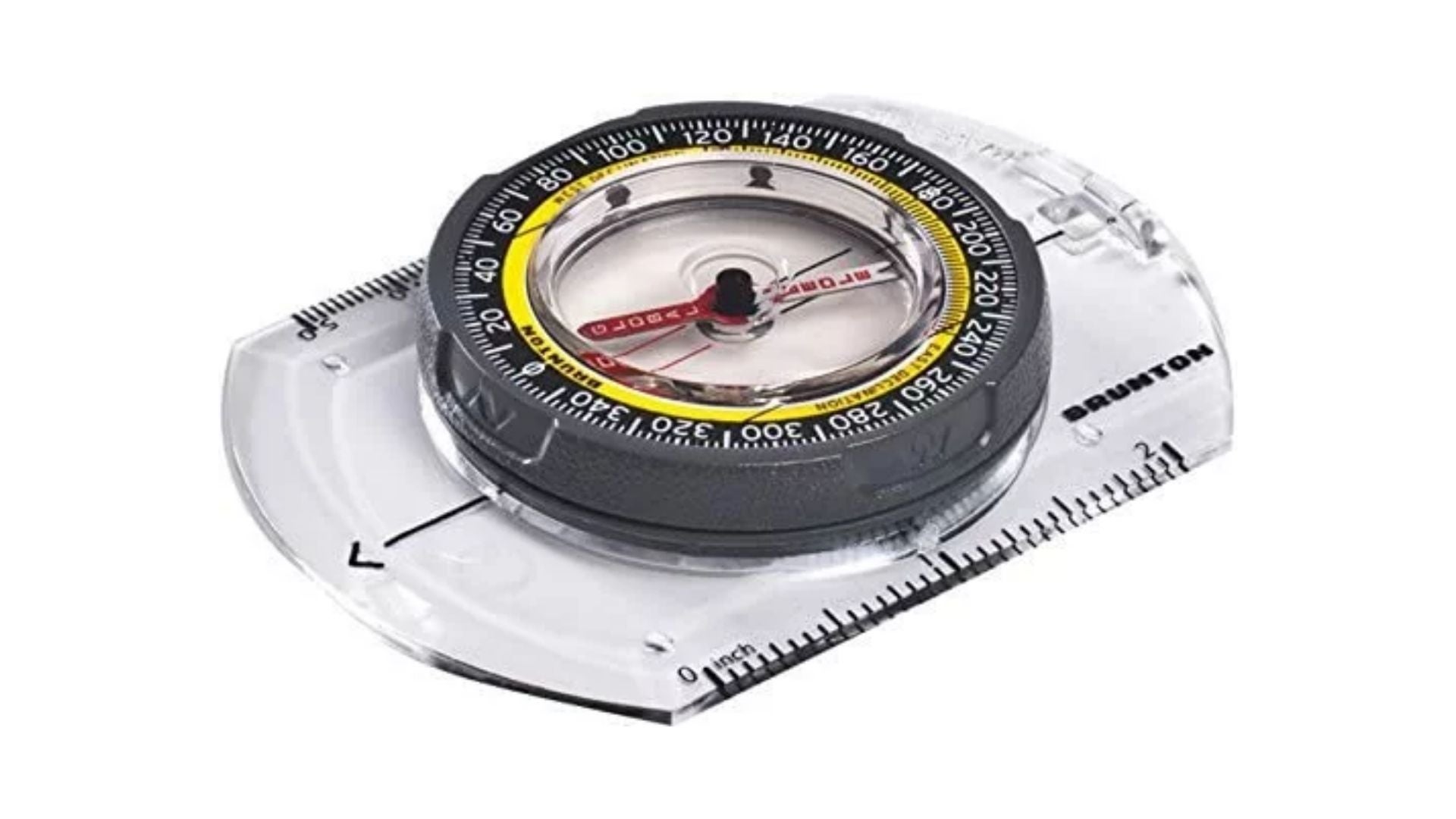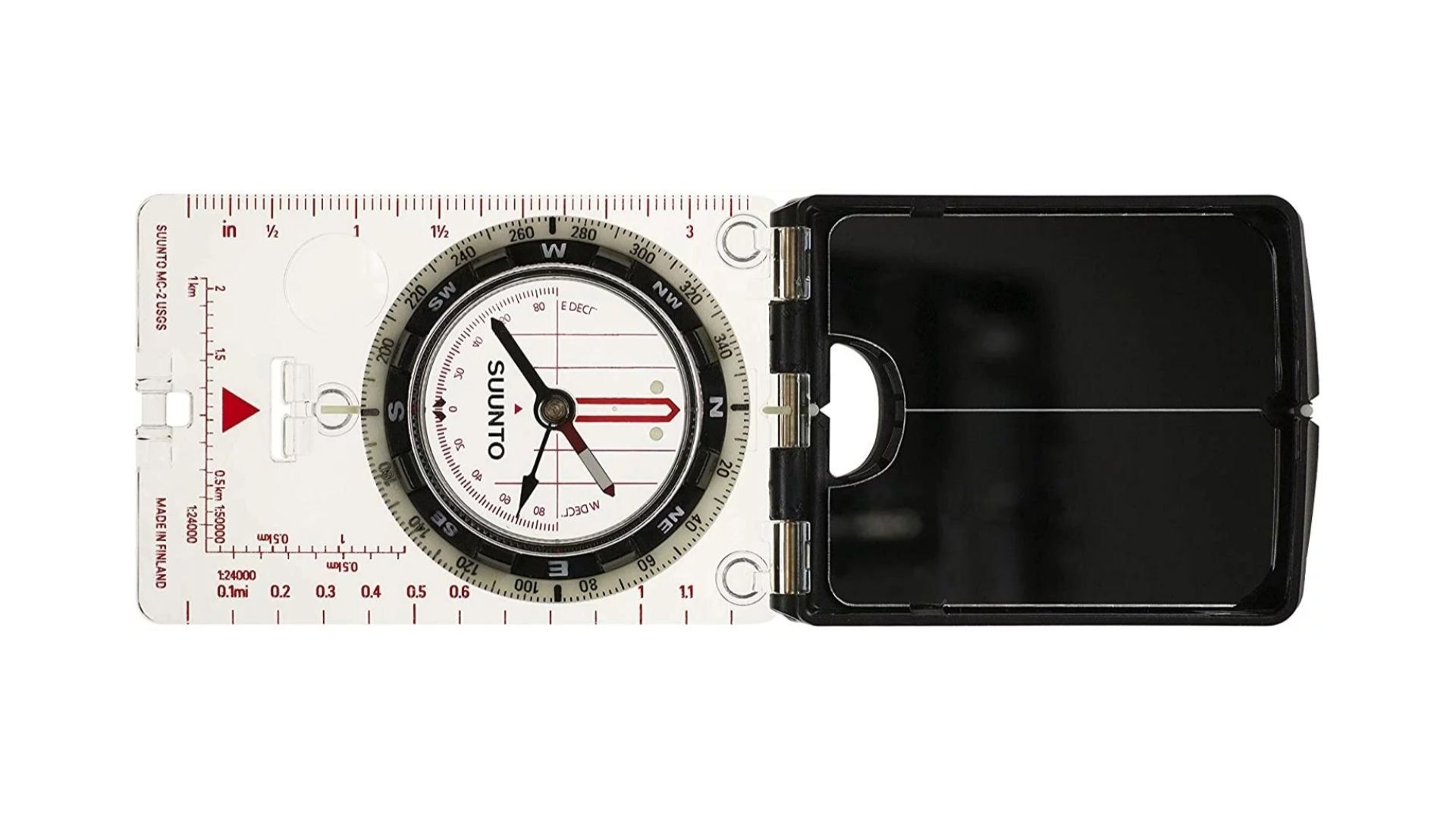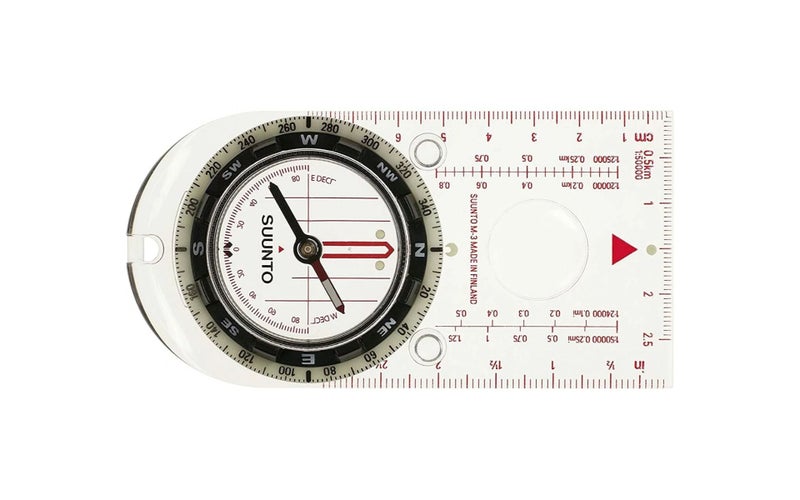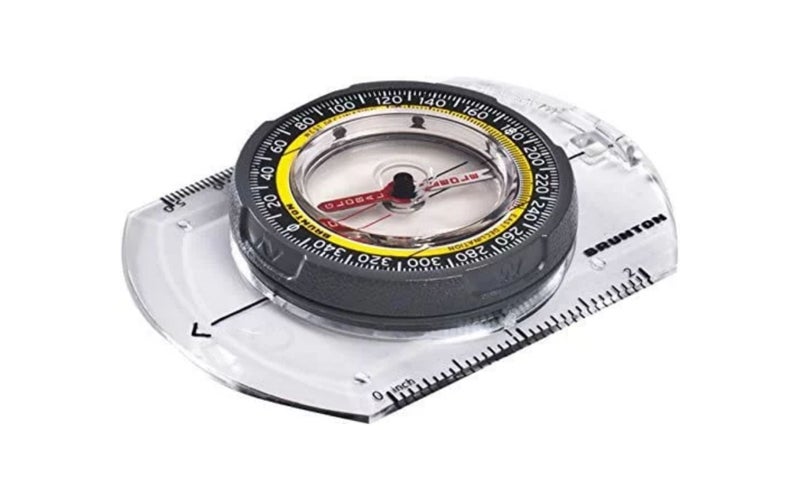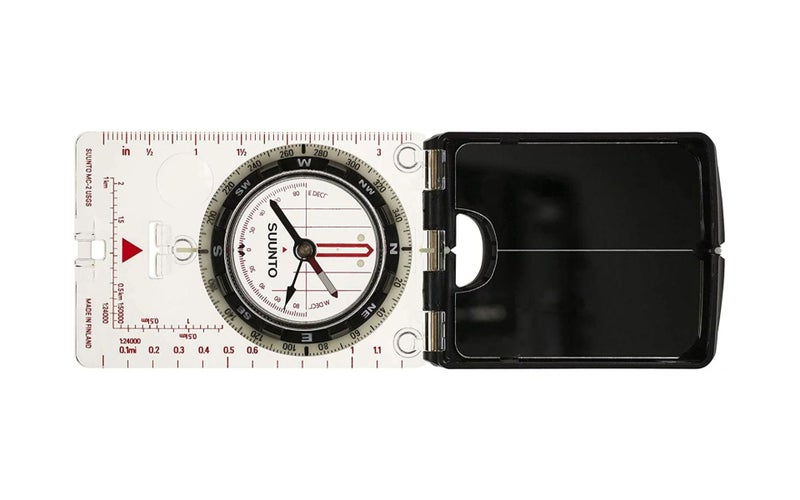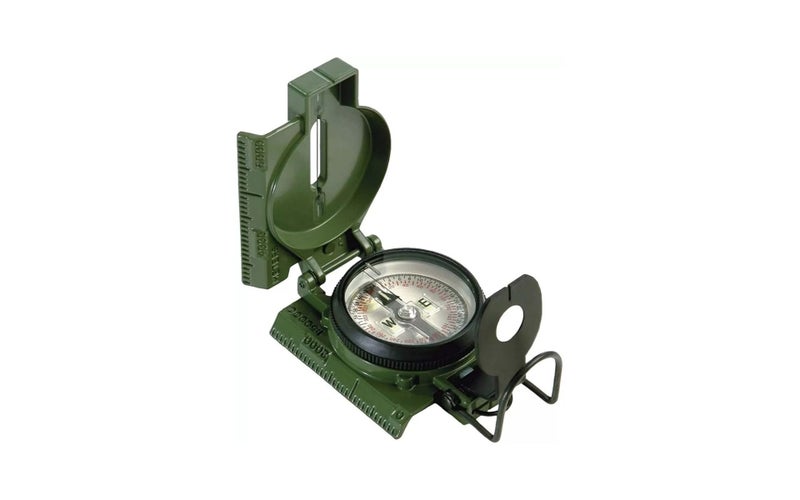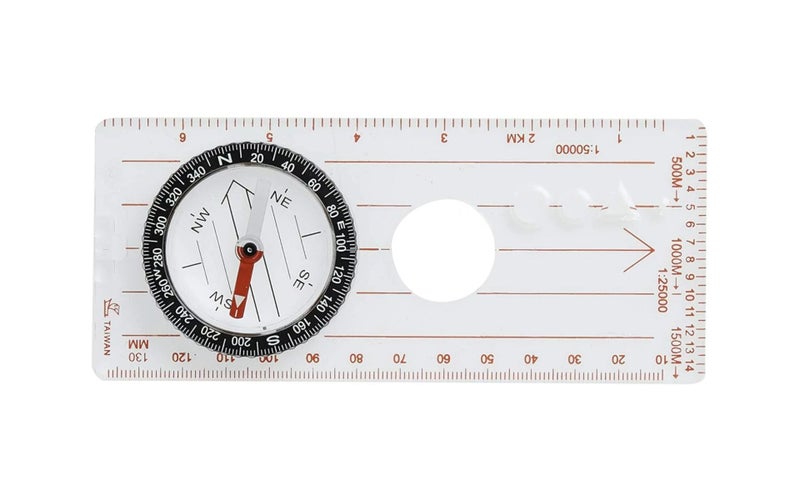We may earn revenue from the products available on this page and participate in affiliate programs.
Why do I need to know which is the best compass when I’ve got a GPS? That’s a great question, and I have a great and simple answer: technology breaks and batteries die. But even if the polar ice caps melt away completely and Las Vegas becomes the finest post-apocalyptic beachfront resort left in the world, the magnetic poles of the Earth will still be magnetic.
We are lucky to live in a time when most of our navigation needs can be solved by the little supercomputer most of us carry in our pockets these days. They can tell you where you are, how to get where you’re going, where there are traffic jams along the way, and where to find the best craft cocktails or authentic street tacos when you get there. But sometimes, that device is no longer an option.
In the world of hiking and orienteering, Suunto is navigation royalty. Founded in 1936 by a Finnish surveyor, the company is mostly known today for its high-end multifunction wrist watches with GPS, altimeter, and compass functions, and their scuba gear. But they never left behind their legacy as a creator of high-quality, reliable magnetic compasses.
I was first introduced to Suunto in 1991 during a land navigation course taught by a Special Forces 18B, or weapons sergeant. During the course, he pointed out that even though he relies on his military-issued compass and GPS, he always kept a Suunto compass in his shirt pocket because when everything went bad or he was separated from his kit, he had a readily accessible orientation on-hand that weighed next to nothing and took up no significant space. I took this advice to heart and started carrying a Suunto in the field. He was not wrong. It got me out of a couple of tight spots over the years.
The Suunto M-3 is a lightweight baseplate compass with a high-grade steel needle encased in liquid with a jewel bearing. The M-3 is functional from minus 22 degrees to 140 degrees Fahrenheit. It has imperial scales of 1:24,000 miles and 1:50,000 miles and metric scales of 1:20,000 km, 1:25,000 km, and 1:50,000 km.
The Suunto M-3 has an adjustable declination correction feature, which allows the user to adjust the declination between true north and magnetic north. This allows the user to navigate without making that adjustment as they go, which can keep you on track more easily.
The Suunto M-3’s clear plastic base plate allows you to place the compass directly on a map to help orient yourself. It has an ergonomically rounded back end, which helps to hold it comfortably in your hand and minimizes accidentally holding it backwards.
One big complaint about the Suunto M-3 is the tool required to adjust the declination correction. The tool itself isn’t an issue, but the Suunto M-3 has no convenient place to hold it. Some users attach it to the lanyard which comes with the compass, which keeps the tool easily accessible.
Some folks don’t care for the lanyard. It is a bright red cord, which makes a great “dummy cord” to tie your compass to a pocket or onto your kit, but it isn’t quite long enough to comfortably wear the compass around your neck — the preferred carry method for a lot of people when orienteering or navigating.
Overall, this is a great compass that is reliable and accurate, and available at a reasonable price.
- Weight: 1.62 ounces
- Material: Plastic
- Type: Baseplate
Available in Northern Hemisphere and Global models
Adjustable declination correction
Lightweight and flat design makes it easy to pack/carry
Ergonomically rounded back end for easy hold
Requires tool to adjust the declination
Lanyard is too short
Luminous markings fade relatively quickly
The TruArc3 baseplate compass is something of a powerhouse in the features you get for a budget-priced compass. First and foremost, for under $20, you get a global compass that can be used equally well in the southern hemisphere as the northern hemisphere. Most other compass models will charge extra for that. The other great feature this model brings is a tool-free declination adjustment, which is a huge benefit since the tools used to adjust the declination in most compasses are small and easy to lose.
This is an excellent beginner’s compass or a backup compass. Its shortcomings include a lack of luminous materials on the bezel and the needle, making it a challenge to use in low-light settings. The baseplate measurements are in inches and centimeters rather than being scaled for map grids, meaning you would have to do good math before stepping off the X. It’s a minor inconvenience, but an inconvenience just the same.
Overall, this is a very solid instrument. It doesn’t quite have all the features we would like to see, but you get a serious compass for the price.
- Weight: 1.3 ounces
- Material: Plastic
- Type: Baseplate
Tool-free declination adjustment
Global needle suitable for use in both the northern and southern hemispheres
Economically priced
Both standard and metric measurements
Baseplate is too small for use as a straightedge on a map
No luminescent materials on the bezel
No magnifying lens on the baseplate
The Suunto MC-2 is one of the most versatile and useful compasses on the market. By now, you’ve probably noticed Suunto features heavily in this guide and there is a good reason — they consistently put out a solid product. The MC-2 is no exception.
The MC-2 has several useful features including a clinometer to measure slope and degree of the terrain, an adjustable declination measure, and exceptional luminous markings for easy visibility in low-light conditions. The MC-2 is functional from minus 22 degrees to 140 degrees Fahrenheit. The sighting hole and notch in the mirrored lid allow the user to get extremely precise directional measurements.
In addition to providing excellent directional measurements, the lid helps protect the compass while you are moving. The mirror can, in a pinch, be used to signal for help. If you are serious about hiking, cross country skiing, mountaineering, trekking, or hunting, this is the compass you want to carry.
The Suunto MC-2 has measurements in inches and centimeters and is available in a Global version suitable for use in the Southern Hemisphere.
- Weight: 2.61 ounces
- Material: Plastic
- Type: Mirror
Adjustable declination setting
Available in Northern Hemisphere and global
Includes clinometer
Luminous markings
Suunto logo on face can interfere with bearing reading
If you ever served a day in the Army or the Marine Corps, you are likely intimately familiar with the Cammenga Lensatic Compass. This is the green metal folding compass you used to learn land navigation and map reading — also known as the M-1950 3H lensatic compass. There is a pretty high chance you had one attached to your field kit. Since 1992, Cammenga has held the DoD contract for lensatic compasses.
Those familiar with the military lensatic compass know it was not only what you used to get you safely from your rucksack to the spot you dug your cathole and back to your rucksack, but also a potential improvised weapon. This slightly bulky hunk of metallic navigation could probably kill or stun a Florida panther if swung with the correct combination of angle and velocity. Seriously, though, the Cammenga lensatic compass was probably the single most durable item of kit issued by the military. Damn close to indestructible.
Despite all the cool guy wazoo stuff other compasses offer, the thing about the lensatic compass is they are durable in just about any weather or condition and they are dead on balls accurate (it’s an industry term).
Several companies make military-style lensatic compasses, but when you put your hard-earned money down on something that could potentially save your life, you go for the real deal. Cammenga is the real deal.
- Weight: 7.2 ounces
- Material: Aluminum
- Type: Lensatic
Reliable from minus 50 degrees to 150 degrees Fahrenheit
Nostalgia — this is the compass most of us learned on and served with
Compass lid locks azimuth in place when not in use
Tritium microlights provide visibility at night
Bulkier than most compasses
Risk of bad memories from basic training/OCS/ROTC
The Coghlan’s Deluxe Map Compass is a very good basic and everyday compass. The compact design was made for beginners. There is an integrated magnifier in the baseplate and scales in millimeters and 1:25,000 making it ideal for orienteering and general map reading. The compass comes with an instruction book.
This is not the compass you want to take on a trekking expedition across the Alaskan wilderness, but it is the perfect compass to teach your kids a useful lifelong skill like map reading and navigation. It’s also a great compass for an easy, casual hike not too far into the deep, dark wilderness, either as a primary or backup compass.
The Coghlan’s Deluxe Map Compass is a very inexpensive, basic compass perfectly designed for kids and novices. It’s a great learning tool for someone looking to enjoy the world of map reading and navigation.
- Weight: 0.96 ounces
- Material: Plastic
- Type: Baseplate
Adjustable declination setting
Available in Northern Hemisphere and global
Includes clinometer
Luminous markings
Suunto logo on face can interfere with bearing reading
Why you should trust us
I was first introduced to compasses and navigation as a young Army private in the mid-1980s. I have done navigation training in a variety of settings — as a candidate for the Army’s Expert Field Medical Badge, during various military leadership schools and military exercises, and as a student in the now-defunct U.S. Army Jungle Warfare Course in the Panamanian jungles. I’m an avid hiker and camper, and even one of those weirdos who has done orienteering as a sport.
In short, I have been using compasses for a very long time. Moreover, as a gear reviewer for Task & Purpose, I earn my keep by poring through pages and pages of professional reviews, customer reviews, speaking to experts, and field-testing gear on my own. Prior to joining the Task & Purpose team, I have relied heavily on reviews for purchases of kit from inexpensive knives to expensive camera equipment. I understand how important it is to be able to rely on getting accurate and up-to-date information from a review, so I make it my mission to bring you the best of the best.
Through Task & Purpose, I work with a team of assorted subject matter experts (think “Guardians of the Galaxy,” but with tactical gear) whom I can rely on to steer me in the right direction when I need some additional information or background.
Types of compasses
Baseplate compass
The baseplate compass is the most common type of compass today. It allows for easy reading of the map because the baseplate is usually made of clear plastic with orienting arrows and lines throughout to make it easier to align the compass with your map and plot points. The baseplate usually includes an integrated magnifier to help read small print and terrain features on a map.
Lensatic compass
The lensatic compass is a type of sighting compass. The lensatic compass has a small magnifying lens on the near side — in fact, the term lensatic comes from the presence of this lens. The lensatic compass is commonly used similarly to a baseplate compass –— level hold and eyeball the degrees — but they are designed to be used for more precision sighting. The cover of a lensatic compass has a long, vertical notch that lines up with the bezel and the magnifying lens to allow the user to get a very specific and precise directional alignment.
Mirror compass
A mirror compass has a lid that goes over the face of the compass. The underside of the lid has a mirror with a long, vertical notch. This allows the user to view their landmark through the notch while using the mirror to accurately view the magnetic needle and bezel. The result can be a more accurate azimuth towards your destination.
Global compass
A global compass is a compass that can be used in both the northern and southern hemispheres. This is particularly useful to those who travel extensively, like the ski bums I met in Bariloche, Argentina, who fled the northern hemisphere in the summer to ski in the Andes Mountains when the seasons reverse.
Thumb compass
Thumb compasses are small compasses designed to be attached to the thumb for more rapid bearings while on the move. They are not commonly used as a primary navigation device, but as a readily accessible backup. They help competitors stay on course without stopping to acquire their azimuth with the more traditional compass. They are similar to the small compass attachments you can attach to your watch strap or embed in the top of your wooden walking stick.
Key features of compasses
Magnetized needle
The magnetized needle — the needle that constantly points to magnetic north — is the core of the compass. Typically, the end of the needle that points north is colored red and the needle is encased in damping fluid to help steady the movement of the needle. Damping fluid is also resistant to freezing in extreme temperatures.
Rotating bezel
The rotating bezel, which is also known as the azimuth ring, is a bezel ring around the outer edge of the capsule in which the magnetized needle is encased. The bezel is marked with degrees from zero to 360. During orienteering, this needle can (and should) be turned to the designated azimuth so the north tip of the magnetized needle lines up with the zero-degree point on the bezel. This creates a visual reference for the navigator to stay on course. The bezel and needle tip are usually equipped with luminous markings to make the lined-up markings visible in low light and darkness.
Baseplate
The baseplate is a flat surface on which the compass needle and fluid compartment are housed. The baseplate is commonly clear plastic and often contains features such as rulers, orienting arrows and lines, an integrated magnifier to help see small map features, and luminescent indicators.
Benefits
Reliability
The biggest benefit of a compass is the reliance on magnetic poles instead of battery power. Unless you break it somehow, a compass always works. Even a compass that has been sitting in the bottom of a gear bag for months will work on demand. There are, of course, considerations to be taken, e.g., your Northern Hemisphere compass isn’t going to do you much good if you get lost hiking in Argentina. Overall, though, they are ready to go when you are.
Fun to use
As a society, we have become very used to instant gratification via electronics. Music on demand. Information on demand. Even navigation on demand. Modern navigation apps available on smartphones will usually immediately tell you where you are and the best way to get where you’re going. When you and a friend are having trouble meeting up, you can just send your friend a pin drop of your location so they can navigate to you. With a compass, you get to engage your brain again and focus on a task. There is a satisfaction that comes from doing something for yourself, especially in this world of instant gratification. Have you ever eaten something you hunted, caught, or grew yourself? Using a compass can give you the same sense of fulfillment.
Portability
Most compasses weigh only a couple of ounces. Most are small and flat, so they take up minimal space in your bag or pocket. They add almost no weight to your gear but can be a literal lifesaver in a bad situation.
Pricing considerations for compasses
Budget
You can pick up a good compass for under $20. There are several very good models that come with the basic needs to navigate and find your way from point to point. These are great for beginners and kids. They are excellent choices if you need to buy several because you want to teach a class in navigation or start an orienteering club. You don’t have to spend a fortune to get a good, quality compass.
Mid-range
There are many great compasses ranging in price from $20 to $50. They come with numerous features and are made with high-quality materials. In fact, most of the compasses the average person wants to look at fall into this range. They are high-quality and reliable and make great additions to your kit. Many of them are solidly built and can take a beating out in the wilderness on a long hike or cross-country ski trip.
Premium
Once you go over the $50 price tag, you are getting into the best of the best. These are the compasses that are the most durable and the most accurate. It is rare to see a compass tilt the scales past $150, so overall, these are affordable toys (ask your photographer friends or shooting enthusiasts). With premium compasses, you will also see a higher caliber of materials. Your luminous materials will hold their glow longer and your magnetic needles will move more smoothly and with more accuracy.
How we chose our top picks
Selecting products for this review was a combination of reading what the experts had to say on the subject, comparing their conclusions, and looking at everything through the prism of my own experience with compasses and navigation.
In addition to expert reviews, I like to deep dive into the experiences of consumers. In other words, I feel I can make a more accurate assessment when I have access to 100 consumer reviews in addition to my own experiences. To round the process off, I like to reach out to others who have had first-hand experience with a product type or with a particular brand.
Luckily, this is a topic I have enough hands-on experience with that I have a pretty good idea of what makes sense and what doesn’t. As always, I wish I had six months to field-test dozens of products and make my own first-hand assessments, but that just isn’t reality.
FAQs on compasses
You’ve got questions, Task & Purpose has answers.
Q. Who invented the compass?
A. Historians believe the magnetic navigational compass was invented by the Chinese, possibly as early as the 11th or 12th century. Pre-navigational compasses were invented during the Han Dynasty sometime between the 2nd century BCE and the 1st century CE.
Q. I’m a new Army lieutenant; what compass should I carry?
A. Two good squad leaders: a jaded corporal, and a platoon sergeant.
Q. What are the best accessories for a compass?
A. The very best accessory you can have for your compass is a map. Without a map, your compass isn’t useless, per se, but you’re extremely limited in your ability to navigate beyond a panic azimuth. Other good accessories are a case of some sort to keep it from getting damaged or beat up. and maybe a length of paracord for a tie-down.
Q. What compass does the U.S. military use?
A. The military typically uses lensatic compasses, which are more durable and rugged than most. Since 1992, the contract for all military compasses has been with Cammenga, whose lensatic compass we named as our pick for Most Durable.
Q. How do you pick a good compass?
A. The most important thing is to assess your needs. Are you teaching your child orienteering as a family weekend activity, or are you solo trekking across the Pacific Northwest? After that, factor in your budget and your skill level — both your current level and the level you wish to achieve. Make sure your compass has a few basics, such as good luminous markings, a solidly fluid encased magnetic needle, and readable markings.
Our gear section
Paul O’Leary is an Army veteran and tactical nerd. He’s served multiple tours in Atropia and other theaters and once ate a Norwegian reindeer MRE. He fancies himself a connoisseur of good bourbon, wine, and cigars. He also writes for Duffel Blog.
